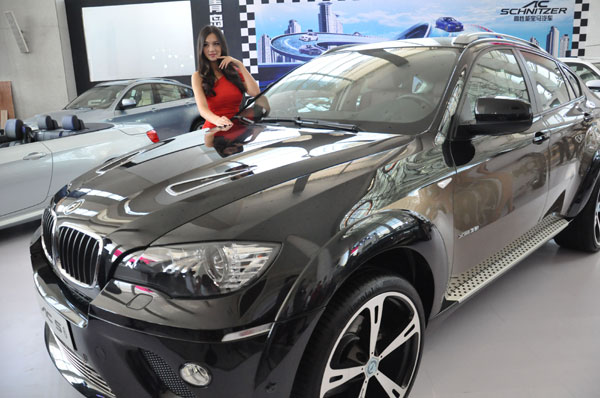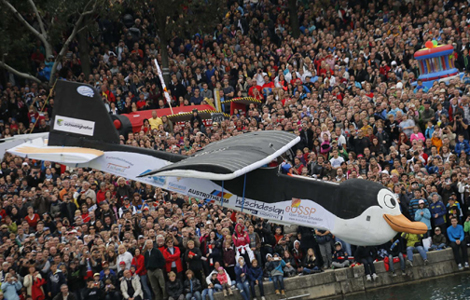Luxury cars roll into new markets
Updated: 2012-09-30 08:08
By Li Fangfang (China Daily)
|
||||||||
|
A BMW car on view at the 2012 Autumn Auto Show in Qingdao, Shandong province, on Sept 14. Huang Jiexian / for China Daily |
"The development of small cities there, such as Kashgar, Korla and Kuche, impressed me a great deal. I can see many cars driving on the roads there which I could not imagine years ago," said Maier.
"We haven't been there with our stores. However, we can now consider establishing small dealerships step by step, to follow our customers."
He also paid a visit to Mercedes' dealership in Urumqi, the region's capital city, where the dealer told him that market demand exceeded his expectations.
"Our growth rates in these third- or fourth-tier cities are much higher than that in first-tier cities, though our major sales are in big cities," said Maier. However, he said, "Going to smaller cities is the base for our future success and long-term development."
Maier said that from this year, Mercedes is speeding up its sales network expansion from its previous plan to add 20 to 25 dealerships a year to opening more than 40 new dealerships annually.
"By the end of this year, we will have at least 300 dealerships around China. And we are going to more third- and fourth-tier cities to seek more potential," said Maier.
"Look at these small cities, which are not on our network expansion list today. I think we can start to prepare for dealership establishment maybe in two years," he said.
Mercedes-Benz is not the only company planning to explore the market potential in China's third- or fourth-tier and even lower-tier cities.
Fellow German luxury car producer BMW Group opened a 4S (sales, spare parts, service, survey) center in Lhasa, capital of the Tibet autonomous region, in late August, making it the first luxury vehicle brand to enter the area and the first luxury brand to cover all capital cities in China's provinces and regions.
"Although we are facing many challenges in Lhasa, which has a small capacity for luxury vehicles, we believe that the market will burgeon after we open the 4S store," said Daniel Kirchert, senior vice-president of sales and marketing at BMW Brilliance Automotive.
"In the last two to three years, many people have been upgrading their vehicles from middle- or even low-end cars to luxury branded vehicles. So we are confident that after three years, business in our Lhasa store will flourish," said Kirchert.
Statistics from BMW show that its year-on-year sales growth in fourth- or fifth-tier cities surged by 50 percent in the first seven months, which is much higher than its overall growth of 30 percent in the Chinese mainland.
In 2011, the German brand entered 23 new cities and now has stores in 290 cities in the mainland. This year, it plans to enter a further 30 new cities.
By the end of this year, BMW has set a target of 350 dealerships in the world's largest automobile market.
"Although China's vehicle market slowed down this year, we won't change our long-term strategy due to short-term market uncertainties. Dealership expansion is key for our future here," said Kirchert.
Vice-Minister of Industry and Information Technology Su Bo agreed.
He said: "China's automobile industry will end its boom over the next 10 years. However, the vehicle sector in third- or fourth-tier cities, and even rural regions, will continue to enjoy stable development in the long term."
Statistics from China Association of Automobile Manufacturers show that the share of new vehicle sales in third-tier city markets increased from 26.7 percent in 2010 to 30 percent in 2011, while that in first-tier cities dropped from 35.7 percent to 30.8 percent during the same period.
Analysts said that third- and fourth-tier city markets will be the major battlefield for automakers in the near future.
According to CAAM, China's domestic automobile market slowed down in 2011, growing only 2.5 percent year-on-year, after booking an impressive annual sales growth of 46 percent in 2009 and 32 percent in 2010.
The slowdown in the automobile sector continued in the first eight months of 2012, with total sales of 1.25 million units, up 4.1 percent year-on-year.
Luo Lei, deputy secretary-general of the China Automobile Dealers Association, said: "Most Chinese people still have a dream of owning a car, especially in smaller cities. The potential in third- or fourth-tier cities is attractive.
"As consumers who are considering their first car are more price-sensitive, the pricing strategy in those smaller cities is important for automakers."
He suggested that before automakers go to low-tier cities, "they need to have a stable and strong foothold in first- and second-tier cities".
Cui Dongshu, deputy secretary-general of the China Passenger Car Association, said: "Along with the transfer of industry from big cities to small and inland cities, vehicle consumption power is also moving to third- or fourth-tier cities, where automobile capacity is low and sales are high."
He said automakers need to adopt a different approach toward expansion in smaller cities.
"We will consider opening smaller dealerships," said Maier from Mercedes. "The strategy will be very flexible, depending on the size of the cities," he added.
Jia Xinguang, an independent auto analyst in Beijing, agreed that "the crazy growth in first-tier cities has ended, while there is potential in third- and fourth-tier cities".
However, Jia said that the markets in those low-tier cities will reach saturation point faster than big cities.
"And after automakers have spurred vehicle consumption in smaller cities, they will face challenges such as traffic congestion," he said.
Going west
After previously focusing on major cities along China's coastline, luxury automobile brands are now turning their attention to the rich opportunities in western regions, where they plan to open more dealerships.
Mercedes-Benz inaugurated its new regional headquarters in Chengdu, Sichuan province, covering western China, at the end of August. It restructured its business with three other regional headquarters this year, in Beijing, Shanghai and Guangzhou for northern, eastern and southern China, respectively, to better manage its growing number of dealerships.
"Over the years, cities in western China, such as Xi'an and Chengdu, have witnessed dramatic growth and changing lifestyles that demonstrate the region's huge market potential," said Bjorn Hauber, executive vice-president of sales and marketing at Mercedes-Benz (China) Ltd.
"Although the region currently contributes 15 to 20 percent of our overall business, it's more interesting that we see the highest growth rates in the western China market, led by the two cities."
According to Hauber, Mercedes' sales in Chengdu this year grew 60 percent year-on-year, outstripping its market performance in first-tier cities.
This rapid growth means that the market is more important than ever to the company's overall development strategy in China, he said. "This, together with the increasing all-round efforts of the Chinese government to further develop the western region, have compelled us to place an even greater focus on achieving sustainable development in this regional market," Hauber said.
Swedish luxury brand Volvo, which was acquired by Chinese carmaker Geely Automobile in 2010, also established its southwestern sales branch last month.
"We plan to expand our dealership network from the current 109 to 250 over the next five years, with most of them in third- or fourth-tier cities," said Ning Shuyong, vice-president of Volvo China.
Toyota's luxury brand Lexus said that in the first seven months, its sales in the southwestern region, including Sichuan, Chongqing, Guangxi and Yunnan, increased 55 percent year-on-year to 16,000 units, accounting for 40 percent of its sales in China.
lifangfang@chinadaily.com.cn











